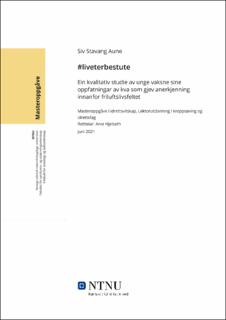| dc.description.abstract | I denne kvalitative studien av friluftsliv som eit sosialt felt har eg undersøkt korleis unge vaksne oppfattar spelereglane i friluftsliv, særleg knytt til faktorar som kunnskap, utstyr og sjølvpresentasjon i sosiale media. Vidare har eg også forsøkt å identifisere kva distinksjonar som kan gje anerkjenning i friluftslivsfeltet.
Ved hjelp av djupneintervju med informantar med ulik erfaring i friluftslivsaktivitet har eg, støtta opp av teoretiske omgrep frå Pierre Bourdieu, Erving Goffman og Thorstein Veblen, identifisert fire faktorar som bidreg til å belyse friluftsliv som eit sosialt felt prega av praksisar som gjev anerkjenning; 1) Å vere ein «friluftsperson», 2) Kunnskapsrangstigen, 3) Sosiale medium sin ambivalens, 4) Catwalken.
Analysen viser at det å vere interessert i friluftsliv, eller det å byggje identiteten sin rundt dette, er verdsett i det sosiale rommet, og kan tene respekt gjennom å etterlate eit synleg resultat som kan skape samanlikningsgrunnlag for andre. Vidare verkar erfaring innanfor friluftsliv å vere av betyding for å forstå den kulturelle koden på feltet, som følgeleg gjer ein i stand til å kjenne att faktorar som gjev anerkjenning, som til slutt mogleggjer ei form for definisjonsmakt når det gjeld spelereglane på feltet. Forståinga av den kulturelle koden kjem til syne gjennom distinksjonane; når ein ikkje lenger kan distingvere seg frå allmennheita ved å ha friluftsliv som interesse og korleis dette er identitetsbyggjande, så kan kunnskapsaspektet, sosiale medium og korleis ein kler seg opne opp for at ein likevel kan uttrykkje feltspesifikk kapital.
Eige kunnskapsnivå er relativt i forhold til andre på feltet, og ein distingverer seg mellom anna gjennom val av mindre kjente turmål. Sosiale medium er ei hyppig brukt informasjons- og inspirasjonskjelde, og distinksjonane kjem til uttrykk gjennom kven ein vel å hente denne informasjonen frå, og kva ein vel å publisere bilete av. Samstundes tyder det på at å framstå som eit friluftsmenneske på sosiale medium er ein markør for anerkjenning. I klede- og utstyrsmylderet handlar det om å passe inn i eksisterande kledekodeksar på feltet. Dyre klede er av betyding, samstundes som ein kan bli avslørt som uerfaren på feltet dersom ferdigheitene ikkje stemmer overeins med inntrykka ein gjev gjennom kleda ein har. | |
| dc.description.abstract | The aim of this qualitative study of friluftsliv (outdoor life) as a field is to examine how young adults comprehend the ground rules in friluftsliv; especially in relation to elements such as knowledge, gear, and self-presentation in social media. The thesis has also aimed to identify the distinctions that may give acknowledgement in the field of friluftsliv.
By using in-depth interviews with interviewees of different experience within friluftsliv I present four factors that contribute to illustrate friluftsliv as a field influenced by practices giving acknowledgement. These are supported by theoretical concepts of Pierre Bourdieu, Erving Goffman and Thorstein Veblen: 1) To be a «frilufts»person, 2) The hierarchy of knowledge, 3) The ambivalence of social media, 4) The catwalk.
The analysis show being interested in friluftsliv or building one’s identity around this is valued in the social space. Furthermore, it can serve respect by leaving a visible result that can create a basis of comparison to others. Experience within friluftsliv seems to be of consequence to understand the cultural code on the field which makes individuals able to recognize factors giving acknowledgement and enable a kind of power to define the rules of the game on the field. The understanding of the cultural code displays through the distinctions; when one does not distinguish oneself from others by having friluftsliv as an interest and a part of the identity, the aspects of knowledge, gear and social media enable the possibility of still expressing symbolic capital.
The subjects’ opinion of their own knowledge is relative to others on the field, and a way to do this is choosing lesser-known hiking destinations as a method of standing out. Social media is frequently used as a source of information and inspiration, and the various distinctions are apparent when looking at where the information comes from, and which photos ends up being posted. Simultaneously, looking like a friluftsliv person on social media also signals acknowledgment. Various clothes and gear become a way to fit into the field’s existing clothing expectations and norms. Although expensive clothes are prevalent, one can be perceived as inexperienced in the field if one’s skills does not align with the image the clothes present. | |
